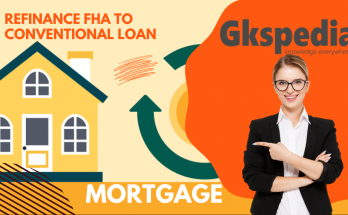Introduction: In the ever-evolving landscape of homeownership, Non-Traditional Home Loans have emerged as a flexible and inclusive solution for aspiring homeowners. These loans offer an alternative path to property ownership for individuals who may not fit the conventional lending mold. In this comprehensive guide, we will delve into the world of Non-Traditional Home Loans, exploring their unique benefits and the potential impact they can have on your journey to owning a home. Whether you’re self-employed, have limited credit history, or simply seek a more flexible financing option, join us as we navigate the intricacies of Non-Traditional Home Loans and empower you to make informed decisions about your homeownership dreams.
What Is a Non-Traditional Loan?
A non-traditional mortgage or mortgage is a type of loan that does not have to meet the requirements of a traditional mortgage. Non-traditional loans may refer to non-conforming loans. Conventional (or conformed) loans use a wide range of qualifications and eligibility, including B. Credit score, loan amount, and debt-to-income ratio. Most traditional loans also require a minimum 20% down payment or personal mortgage insurance payment.
Non-traditional mortgages are often government-sponsored and therefore offer more flexible eligibility requirements. Department of Agriculture is all federal agencies that arrange these non-traditional homeownership loans.
Non-traditional mortgages generally represent mortgages that do not have typical traditional features. These can relate to any kind of mortgage that does not follow a standard amortization schedule or has standard installments.
Non-traditional mortgages often have higher interest rates due to the higher payment risk associated with the loan. Examples of this are balloon loans, hybrid ARMs, and interest-free mortgages.
Understanding Non-traditional Mortgages
A mortgage is an instrument of debt used to purchase a house, land, or another type of real estate. The owner pays a set amount of payments (a combination of principal and interest) over a period of time. This period is called the repayment period. Mortgages are secured by real estate, so if the mortgage lender defaults, the lender can pledge assets.
Traditional mortgages are simply structured, where the mortgagee borrows at a fixed or variable rate and makes payments until the loan is fully repaid. It offers predictability to borrowers, so there are no surprises when it comes to monthly payments or loan expiry dates.
Non-traditional mortgages are different in that they offer different options to borrowers. These products offer borrowers more flexible repayment terms and the ability to defer payments. Primarily principal, but sometimes also interest. This reduces the amount borrowers initially owe and ensures that the balance is paid in full.
These types of mortgages often carry higher risks. This is because the risk of default increases. Each of these mortgages has wealth and income requirements. However, there are trade-offs. Lenders can charge borrowers higher interest rates. Nontraditional mortgages are typically made to borrowers in nontraditional situations, such as subprime borrowers. They may not have another place to borrow money, so they are generally willing to accept higher interest rates along with the flexibility they offer.
How Does a Non-Traditional Loan Work?
Fannie Mae and Freddie Mac are government-sponsored financial firms that invest in mortgages. The Federal Housing Finance Agency sets rules on the types of mortgages that can be purchased. All loans meeting these criteria are known as non-compliant loans. They are usually too big or do not meet certain of her FHFA requirements.
Traditional Vs. Non-Traditional Loans
One of the main differences between traditional and non-traditional loans is the credit rating and required down payment. Private lenders offer classic loans and the buyer should have a good credit rating.
Traditional loans are either fixed rates or variable rates. The fixed interest rate on the mortgage will not change. Variable-rate mortgages often start with lower interest rates and lower monthly payments. However, if property taxes or homeowners insurance premiums change, interest rates will rise.
Government programs support unconventional lending and have low credit requirements and large down payments. However, the credit limits for unconventional loans are also lower.
His two main types of unconventional government-backed mortgages are FHA loans and VA loans. The government will secure FHA loans that allow for lower requirements to obtain these loans. Veterans Affairs Loans (VA) are available for military personnel and their families. These loans may not allow a down payment, but ultimately the VA will handle the approval process.
Types Of Non-Traditional Loans
Depending on how long you’ve been in the real estate industry, you’ve probably heard of various unconventional loans. Read the list below to understand the different types of non-compliant loans available.
- FHA: Federal Housing Administration-insured loans are one of the most common types of nonconforming loans. This is due to the low deposit requirements. Middle-income homebuyers can benefit from these loans, but there are some credit guidelines. The FHA loan application process is easy to access as it is issued by most mortgage lenders.
- USDA: The United States Department of Agriculture supports USDA loans for rural development. Loan applicants must be considering properties in cities with less than 20,000 eligible residents. Other requirements include stable income and a credit score of 640 or higher. The property must also be the renter’s primary residence. VA: Active duty military personnel and certain groups of veterans may apply for VA loans through the U.S. Department of Veterans Affairs. One of the biggest advantages of this type of loan is that it doesn’t require a down payment. “Veterans Loans allow us to live closer to military bases and have constant interaction with other military personnel,” said Cliff Auerswald, president of AllHis Rivers, Inc.’s Morning Company. I’m here.
- Crowdfunding: Crowdfunding is perhaps one of the most interesting developments of new technology in the real estate industry. This process involves financing real estate from a group of people rather than a single loan. The division of homeownership depends on the decision made at the time of financing. However, it is also an interesting option for investors and first-time homebuyers.
- Seller Financing: In this arrangement, real estate funds are borrowed directly from the previous owner who is selling the home. This unconventional setting is attractive because it allows homebuyers to bypass strict mortgage requirements. But often it comes in exchange for higher interest payments. In most cases, properties do not advertise seller financing, so feel free to ask. If you do this, make sure you have a specific pitch.
- Holding Mortgage: A holding mortgage is similar to a seller’s loan in that the previous owner acts as the lender. However, with a holding mortgage, the previous owner retains ownership until the new loan is paid in full.
- Private and Hard Money Lenders: Private and hard money are he two of the most common sources of funding among real estate investors today. This path involves finding an investor to act as a lender and fund the property. The buyer repays the loan directly to the lender with interest. Again, this non-compliant financing method is a great way to circumvent potentially more stringent mortgage approval requirements. Jumbo Loans: Jumbo loans are loans too big for Fannie Mae or Freddie Mac to raise money. It might sound intimidating, but there’s good news. Interest rates on jumbo loans are generally similar to traditional loans. To qualify for a jumbo loan, you must meet stricter eligibility criteria set by lenders.
- Purchase Money Mortgage: Purchase Money Mortgage is another option that is used directly between the buyer and the seller. In this arrangement, the buyer essentially purchases the property using a loan from the seller. Most common when the buyer fails to meet other funding requirements.
- With a balloon repayment loan, both principal and interest are deferred until the maturity date. When the mortgage is due, the borrower must make a lump sum payment. Balloon loans can also be designed with net interest payments. Balloon payment mortgages are commonly used by property developers. They generally carry higher interest rates and offer payment deferrals.
- Similar to balloon payment loans, interest-free loans are often offered by developers as well. These loans require the borrower to make regular interest payments and repay the principal at maturity. In real estate development, many property developers use take-out loans at maturity or refinance with secured balloon amortization loans once the loan is built.
Adjustable rate mortgages (ARMs) with payment options are one of the most flexible non-traditional loans, offering mortgage borrowers a number of payment options. These loans follow a variable rate mortgage framework but allow borrowers to choose the type of payment they want each month.
Payment Options ARMs require fixed interest payments during the first months or years of the loan. The loan then reverts to an adjustable rate loan. This typically charges the lender a higher margin to compensate for some of the higher risks. ARM payment options allow the borrower to choose from several options offered by the lender when making monthly installments. Payment options typically include a low fixed rate option (interest-only payments) based on the interest rate for the introductory period or fully amortized 15 or 30-year payments.
Payment option ARMs can be complicated for both borrowers and lenders as they involve negative amortization. ARM payment options add unpaid principal or interest less than standard payments to the borrower’s unpaid principal and increase the amount of interest charged on subsequent payments.
Benefits Of Non-Traditional Loans
Non-conforming loans offer a variety of benefits, including:
Low down payment requirements: In general, non-compliant loans have relatively low down payment requirements. You don’t even have to pay a down payment if you qualify for a USDA or VA loan.
Better Credit Limits: If you’re looking to buy expensive real estate, you’re in luck because jumbo loans are available. This type of non-compliant loan offers higher loan limits compared to compliant loans.
Access to more property types: Non-compliant loans are less stringent in terms of loan terms, down payment, and maximum amount, so you instantly have more options regarding the type of property you buy. Relaxed credit requirements: If you have a low credit score or a negative mark on your credit score, you may be in luck. Non-compliant loans are subject to less stringent requirements. If you have a history of bankruptcy, you may be admitted. However, keep in mind that in most cases, you will have to pay more interest on this type of loan.
Impact Of Non-Traditional Loans
Investment Market impact on Non-Traditional Mortgage
One question that clearly comes to mind with this increase is The market for non-traditional mortgage products their secondary market Product after creation. The department reviewed the bank’s portfolio and No signs yet of these institutions buying Mortgage-backed investments that contain only interest rate or payment option products. These products are not typically purchased from Fannie Mae or Freddie Mac.
Most financial institutions purchase mortgage-backed securities from these GSEs. sauce. The aftermarket for these products includes Other financial service providers and companies, including significant investors located outside the United States. Portfolios containing subprime Only interest rates and adjustable mortgage investments represent an inappropriate risk Insured Depository Institutions and Department Portfolio Continuation To monitor investment activity in this area.
The Potential Impact on Non-Traditional Mortgage
Increased adoption of these products in certain high-growth markets may have caused this Impact on the market itself: These products are prevalent in certain sectors. Markets like California and other areas where the market is growing in Value have pushed the majority of buyers into this product and have been able to qualify for Mortgage and current income. Atlanta Market Reportedly Has Best Value The number of interest loans in the country, recently estimated at 50.4% of his mortgage Issued for the purchase of a single-family house. footnote 1, there are some concerns. A significant contraction in the housing market with little or no homeowner assets In their home they may choose to stay away from them for these mortgage products Commitments similar to those that occurred in certain Gulf markets in the 1980s. or
The impact on the residential real estate market of large volumes of such properties Having to liquidate can be a serious problem. if there was a material number of such qualities Entering the market at the same time can cause home prices to fall. Market impact of newly built properties and impact on the stock property for sale.
How To Qualify For An Non-Traditional Mortgage Loan
Non-traditional mortgages facilitate home ownership for people who might otherwise not be eligible. These loans have simpler requirements than traditional loans. Non-traditional mortgage down payment requirements can be as high as 3%, but acceptable loan values are in the 500 range.
His Dave Herman, president of EZ Surety Bonds, said:
It’s important to note that the details of non-traditional mortgages vary by type. Note that not everyone fits all types. Some non-traditional loans include demographic boundaries such as: B. Eligible veterans and their families, or low-income rural homebuyers.
As previously mentioned, loan products that do not meet the requirements of traditional loans are considered nontraditional mortgages, even if the federal government does not support them. Nearly half of mortgages are now originated by alternative mortgage lenders, according to NerdWallet.com. This indicates a strong and growing demand for non-traditional mortgages. Investors looking for non-traditional mortgages can rely on the performance of other properties to finance. Depending on the lender, the investor may provide figures from past real estate transactions to establish a relationship with the lender. Various non-traditional loan types fall into his three main sources: online lenders, marketplaces and brokers, or non-bank lenders. Investors should adjust their approach based on potential loan sources.
Online Mortgage Lenders
You’ve seen at least one Rocket Mortgage commercial on TV. Quicken Loans launches Rocket Mortgage. This is one of the most important companies in the new generation of online mortgage lenders. Online lenders use credit decision algorithms to provide consumers with a mortgage and refinancing approvals in minutes. These unconventional mortgage programs appeal to many millennials, today’s largest group of homebuyers, who prefer instant gratification by purchasing products online.
Marketplaces And Brokers
Similar to the concept of online mortgage lenders, many popular websites such as Zillow and LendingTree offer a list of potential loan products for consumers to choose from. Algorithms take the buyer’s basic information and perform a search that matches non-compliant mortgage rates with the products the lender is offering. Consumers then select their preferred products and work directly with the lender to complete the application process. These marketplaces and brokers, who can be considered intermediaries, are charged a fee for providing leads to lenders.
Non-Bank Lenders
Small lenders and credit unions offer alternatives for homebuyers with less-than-perfect credit. These facilities are often not subject to as many federal regulations as their counterparts, allowing banks to offer more flexible options to consumers. In the wake of the housing crisis, many large banks have scaled back their mortgage underwriting activities and limited their products to the most eligible borrowers. In recent years, non-bank lenders have increasingly filled this gap.
How To Buy A Home With An Non-Traditional Loan
- Even if you want to buy a house, it’s easy to get discouraged when you’re trying to pay off a debt or save enough money for a down payment. It’s important to realize that non-traditional mortgages are becoming increasingly popular, making homeownership more accessible to those who can’t or don’t want to get a traditional mortgage. . If you are interested in purchasing property on non-compliant loans, please follow these steps:
- Compare Online Mortgage Origins: Online lenders typically offer flexible product options compared to brick-and-mortar lenders. Take your time and compare online mortgage lenders that offer loans with low credit scores and online mortgage lenders with low down payments. Note that interest rates are higher than usual and buyers should exercise due caution and research thoroughly before making a decision. Meet with a credit union: Credit unions are often forgotten by borrowers. Still, it’s an institution that often offers great deals compared to traditional banks, especially if you’re a long-time member. Talking to a credit union representative to review loan programs, including first-time homebuyer programs, can be a great deal.
- Identify another solution: A new homebuyer shouldn’t automatically write off a traditional lender, and always has to talk to her at least once. In some cases, lenders may be willing to work with homebuyers to come up with creative solutions. B. Offer to combine alumni student loans with mortgage payments or increase the loan-to-loan value ratio. Check Non-Compliant Loan Types above for more alternative solutions.




